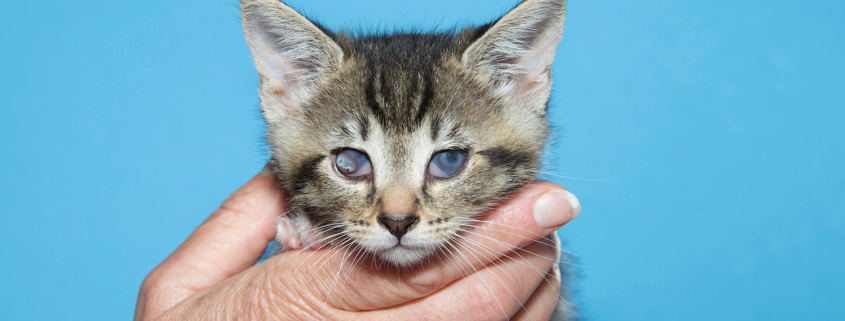How to Treat A Corneal Ulcer in Cat
Anyone can tell you that a cat’s eyes are often what catches their attention first. They are resilient and striking; however, they do sustain injuries or corneal ulcers on the odd occasion. Corneal ulcers in cats are a common complaint within the confines of veterinarian offices – with a bit of care and treatment, you can protect your cat’s eyes from permanent damage. Let’s look at what corneal ulcers in cats are and how you can treat your beloved pets.
What Is the Cornea of a Cat’s Eye?
Simply put, the cornea is the thin membrane that covers the forward-facing portion of the eyeball. The membrane is completely transparent, almost like a window, and protects the eye’s inner structures. The entire cornea is about half the thickness of a dime. It is much the same as the cornea found in the human eye. The cat’s cornea, like the human’s, is composed of three layers: the epithelium on the outside, the stroma on the inside, and the Descemet membrane at the deepest point. Because all three layers of the cornea are transparent, it is impossible to tell them apart with the naked eye. Vets examine the cornea using special pigmented eye drops containing a green dye that highlights cells in specific layers of the cornea.
What Are Cat Corneal Ulcers?
As a pet owner, you might wonder what a corneal ulcer is and what it means for your cat. A cat corneal ulcer – also known as a cat-eye ulcer – is a wound found on the surface of a cat’s eye. It is caused by trauma to the eye, such as corneal abrasion, or by something getting lodged in your pet’s eyes. Cat-eye ulcers can be challenging to detect by simply looking at your cat’s eye. This is why your vet may use a fluorescein stain to detect, diagnose, and monitor corneal ulcers in your cat. The orange-colored dye will help highlight any damage to the sensitive tissues in the cornea. Tissues that have been ulcerated or damaged will absorb the orange dye and turn green. While large ulcers in the eye can be easily spotted – specific lights, filters, and magnification might be required for a mild corneal ulcer or more minor superficial ulcers.
What Causes Corneal Ulcers in Cats?
There are many reasons a cat might have a corneal ulcer—from hereditary conditions to sustained injuries from fighting with other cats to accidental tears. The most common causes of cat corneal ulcers include:
- Blunt trauma – Cats that are active and enjoy being outdoors might obtain blunt trauma to the eye as they play and walk outside.
- Fighting – scratches from fighting with other cats or animals in a fight can leave the eye’s surface damaged or introduce bacteria.
- Dirt – a piece of dirt that becomes trapped beneath the eyelid or becomes lodged in the eye
- Caustic chemical exposure – caustic chemicals can erode at the eye’s surface.
- Viral or bacterial infection – viral infections such as feline herpesvirus can result in corneal ulceration in cats
- Genetic or medical conditions – conditions that reduce the eye’s ability to make tears or susceptibility to viral infection can result in chronic or recurrent infections.
Signs and Symptoms of a Cat Corneal Ulcer
Corneal ulcerations are incredibly painful. Your cat may rub and attempt to groom the affected eye with a paw or by scratching its head on the ground, such as on the carpet or a rug. You might notice that your cat is displaying symptoms of an ulcer by a change in behavior and temperament. Be on the lookout for these symptoms:
- A red, inflamed eye – The eye itself might be inflamed with the surrounding flesh swollen and red with a slight warmth to touch.
- A weepy eye – Liquid or puss weeping from the eye. Congealed and sealed look with a crust that forms
- A painful eye (closed/squinting) – bright light hypersensitivity and avoiding being touched.
- A cloudy eye – slight cloudiness and milky white/blue filmy appearance to the eyeball.
- An obvious crater, hole, rip or dip on the eye’s surface.
How is a Corneal Ulcer Diagnosed?
If you suspect your cat has an issue with its eye, it is best to take your pet to a vet where diagnostics can be done. Leaving your cat undiagnosed and untreated can prolong the pain and lead to long-lasting damage or possible infection. Your veterinarian will need to examine the affected eye using several methods or diagnostics. As the naked eye does not always see corneal abrasions in cats, your vet may want to use a fluorescein stain test to diagnose the ulcer accurately. Once the eye has been examined, your vet will discuss the best possible treatment plan with you and a possible prevention plan for future ulcers, especially if your cat suffers from recurrent corneal ulcers.
Bacterial and Recurrent Corneal Ulcer Diagnosis
If your cat has been diagnosed with a recurrent or more severe ulcer, your veterinarian might want to take additional tests such as culture and cell study. These tests will check to see whether there is a fungal or bacterial infection causing the recurrent ulcer. Getting to the root cause of the ulcer is vital for the treatment to heal the ulcer effectively. Untreated corneal ulceration in cats can result in bacterial infections. This is why it is crucial to assess your cat to prevent bacterial infections or complete damage to the cornea.
Treating Cat Corneal Ulcers
Treating feline corneal ulcers properly from the beginning is key to ensuring not only your feline friend’s comfort but to ensure that it heals appropriately without further complications and damage to the vision centers of the eye. While mild or minor corneal abrasions generally heal well, your vet might recommend a treatment plan to prevent further damage or recurrent infection of the corneal surface. Here are the most common treatments used to treat corneal ulcers:
-
- Antibiotic ophthalmic drops – Once a cat’s eye has been injured, the next step is ensuring that infection is prevented. As infection can prevent proper healing and prolong the process, treating the area with an antibiotic ointment or drops is imperative. Here are the most common treatments used to treat corneal ulcers:
- Regenerative drops – Regenerative medicine uses the body’s natural abilities to heal itself. It offers your cat’s eye a chance to recover from within. Drops such as Vetrix EyeQ Eye Drops are a simple way to provide regenerative care to your cat’s eye.
- Pain relief – If your cat is in pain and the area surrounding the eye is inflamed, your vet may prescribe an anti-inflammatory or pain relief medication.
- Care – Keeping the affected eye clean and safe from further damage is essential; your vet may recommend a cone or that your cat needs to wear eye patches until it is completely healed.
Frequently Asked Questions
How long does a corneal ulcer take to heal in cats?
Each ulcer heals at a different rate depending on its cause and the severity of the ulceration. A deep ulcer might require several treatments over a few weeks, while tiny ulcers might heal within a week with proper treatment. If you are concerned that your cat’s ulcer is not healing fast enough, speak to your vet.
Will a corneal ulcer heal on its own?
Some ulcers might be able to heal on their own. Its ability to heal on its own depends on the severity of the wound and what caused the ulcer in your cat’s eye. It is best to consult your veterinarian.
Is cat-eye ulcer painful?
Corneal ulcers in cats can be painful depending on how deep the abrasions are or the root cause of the ulcer.
Can a cat live with an eye ulcer?
Cats can live with minor corneal ulcers. It might be uncomfortable and cause mild to moderate pain for your cat – however, with a precise treatment plan from your veterinarian and monitoring, you can ensure that your pet is as comfortable as possible.
Can corneal ulcers cause blindness?
Yes, in short, an untreated corneal ulcer in a cat can lead to permanent damage and vision loss. It depends on the severity of the corneal injury and whether your cat allows it to heal by not touching it and further damaging the tissues.
Types of Cat Corneal Ulcer
There are a few different types of corneal ulcers in cats. The type of ulcer is essential as it can help you understand how to assist in its healing.
- Corneal Abrasion or Erosion occurs when one or more of the layers in a normal cornea are structurally damaged due to trauma. Recurrent Corneal ulceration can occur as a result of repeated trauma or infection in the eye.
- Superficial corneal abrasions – light or minor scratches to the eye’s surface can be considered superficial ulcers. They are a little easier to treat.
- Corneal Edema – Caused by the cornea drying as a result of dysfunctional tear ducts – this type of corneal injury can cause repeated ulcers in your cat’s eye. It is often treated with daily eye drop tinctures or synthetic tears to prevent ulcers from forming. However, once an ulcer has formed, it will need to be treated accordingly to avoid further damage.
Treating Cats Corneal Ulcers with Vetrix
Treating cat corneal injuries is difficult because so many factors can prevent the healing process from leading to long-term vision damage or complete blindness. Treatment should ideally aid in the regeneration and repair of corneal tissue while causing as little disruption to the cat’s vision as possible. As a result, regenerative solutions are being used in treating corneal ulcers as a more modern inclusion strategy. Vetrix EyeQ Eye Drops are an easy way to give your cat’s eye regenerative care. These amniotic eye drops use intrinsic growth factors and other components to modulate inflammation, provide just enough lubrication for protection, and promote healing by encouraging cellular growth. Regenerative medicine promotes a faster healing process with higher success rates.
Preventing Corneal Ulcer in Cats
Prevention is better than cure. If your feline has a habit of getting into fights with other cats resulting in corneal injuries – consider building your cat a catio, where they can experience the outside world while remaining safe indoors away from other cats that might want to fight with it. Speak to your vet about fighting and aggressive behavior. If your cat suffers from corneal ulcers from bacterial infections, it is vital to speak to your vet about a preventative program. Speak to your vet about Vetrix EyeQ drops for a regenerative healing solution.




